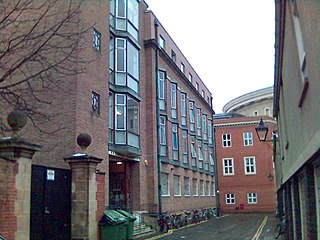
Papyrus is a material similar to thick paper that was used in ancient times as a writing surface. It was made from the pith of the papyrus plant, Cyperus papyrus, a wetland sedge. Papyrus can also refer to a document written on sheets of such material, joined side by side and rolled up into a scroll, an early form of a book.

The Ashmolean Museum of Art and Archaeology on Beaumont Street, Oxford, England, is the world's second university museum and Britain's first public museum. Its first building was erected in 1678–1683 to house the cabinet of curiosities that Elias Ashmole gave to the University of Oxford in 1677.

The Arthur M. Sackler Gallery is an art museum of the Smithsonian Institution in Washington, D.C., focusing on Asian art. The Sackler Gallery and the Freer Gallery of Art together form the National Museum of Asian Art in the United States. The Freer and Sackler galleries house the largest Asian art research library in the country.

The Heracles Papyrus is a fragment of a 3rd-century Greek manuscript of a poem about the Labours of Heracles. It contains three unframed colored line drawings of the first of the Labors, the killing of the Nemean lion, set within the columns of cursive text. It was found at Oxyrhynchus and is one of the few surviving scraps of classical literary illustration on papyrus. The fragment measures 235 by 106 mm.

Arthur Mitchell Sackler was an American psychiatrist and marketer of pharmaceuticals whose fortune originated in medical advertising and trade publications. He was also a philanthropist and art collector.

Oxyrhynchus is a city in Middle Egypt located about 160 km south-southwest of Cairo in Minya Governorate. It is also an archaeological site, considered one of the most important ever discovered. Since the late 19th century, the area around Oxyrhynchus has been excavated almost continually, yielding an enormous collection of papyrus texts dating from the Ptolemaic Kingdom and Roman Egypt. They also include a few vellum manuscripts, and more recent Arabic manuscripts on paper

The Faculty of Oriental Studies, is the University of Oxford's department of Asian and Middle Eastern Studies.

The Oxyrhynchus Papyri are a group of manuscripts discovered during the late nineteenth and early twentieth centuries by papyrologists Bernard Pyne Grenfell and Arthur Surridge Hunt at an ancient rubbish dump near Oxyrhynchus in Egypt.

Papyrus 113, designated by 113, is a fragment of an early copy of a section of the New Testament in Greek. It comes from a papyrus manuscript of the Epistle to the Romans. The surviving text features parts of Romans 2:12-13 on one side of the fragment and parts of 2:29 on the other.

Papyrus 121, designated by 121, is an early copy of the New Testament in Greek. It is a papyrus manuscript of the Gospel of John. The surviving texts of John are only fragments of verses 19:17-18,25-26. They are in very fragmentary condition. The manuscript paleographically has been assigned to the 3rd century by the INTF.

Papyrus Oxyrhynchus L 3525 is a copy of the apocryphal Gospel of Mary in Greek. It is a papyrus manuscript formed in a roll. The manuscript had been assigned palaeographically to the 3rd century. It is one of the three manuscripts and one of the two Greek manuscripts of the Gospel of Mary. It is shorter than Papyrus Rylands 463.
Dirk D. Obbink is an American papyrologist and classicist. He was Lecturer in Papyrology and Greek Literature in the Faculty of Classics at Oxford University until 6 February 2021, and was the head of the Oxyrhynchus Papyri Project until August 2016. Obbink was also a fellow and tutor in Greek at Christ Church Oxford, from which role he was suspended in October 2019.
Mortimer David Sackler was an American-born British psychiatrist and entrepreneur who was a co-owner, with his brother Raymond, of Purdue Pharma. During his lifetime, Sackler's philanthropy included donations to the Metropolitan Museum of Art, the Tate Gallery, the Royal College of Art, the Louvre and Berlin's Jewish Museum.

The Faculty of Classics, previously the Faculty of Literae Humaniores, is a subdivision of the University of Oxford concerned with the teaching and research of classics. The teaching of classics at Oxford has been going on for 900 years, and was at the centre of nearly all its undergraduates' education well into the twentieth century.
Reputation laundering occurs when a person or an organization conceals unethical, corrupt, or criminal behavior by performing highly-visible positive actions with the intent to improve their reputation and obscure their history.
The Sackler family is an American family who founded and own the pharmaceutical companies Purdue Pharma and Mundipharma. Purdue Pharma, and some members of the family, have faced lawsuits regarding overprescription of addictive pharmaceutical drugs, including OxyContin. Purdue Pharma has been criticized for its role in the opioid epidemic in the United States. They have been described as the "most evil family in America", "drug dealers" and "the worst drug dealers in history".
P.A.I.N. is an advocacy organization founded by Nan Goldin to respond to the opioid crisis, specifically targeting the Sackler Family for manufacturing and distributing the drug Oxycontin through their corporation Purdue Pharma LP.
Philanthropy poses a number of ethical issues:

Robert Adam FRIAS FRSA is a Driehaus Architecture Prize winning British architect, urban designer and author, known for championing classical and traditional styles. Adam is a visiting professor at the University of Strathclyde and Design Council Expert.
















